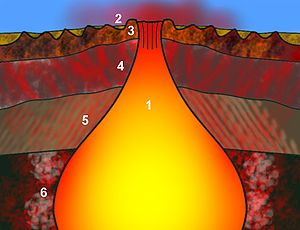Ophiolite Stratigraphy

|
A simplified structure of an ophiolite suite:
1. Axial magma chamber.
2. Sediments.
3. Pillow basalts.
4. Sheeted basaltic dykes.
5. Layered gabbro.
6. Dunite/peridotite cumulates.
(http://en.wikipedia.org/wiki/Ophiolite)
|
The stratigraphic sequence observed in ophiolites corresponds to the lithosphere-forming processes at mid-oceanic ridges:
- Sediments: muds (black shale) and cherts deposited since the crust formed.
- Extrusive sequence: basaltic pillow lavas show magma/seawater contact.
- Sheeted dikes: vertical, parallel dikes which fed lavas above.
- High level intrusives: isotropic gabbro, indicative of fractionated magma chamber.
- Layered gabbro, resulting from settling out of minerals from a magma chamber.
- Cumulate peridotite: dunite-rich layers of minerals that settled out from a magma chamber.
- Tectonized peridotite: harzburgite/lherzolite-rich mantle rock.
An international conference on ophiolites in 1972 redefined the term ophiolite to include only the igneous rocks listed above, excluding the sediments formed independently of the crust they sit on.This definition has been challenged recently because new studies of oceanic crust by the Integrated Ocean Drilling Program and other research cruises have shown that in situ ocean crust can be quite variable, and that in places volcanic rocks sit directly on peridotite tectonite, with no intervening gabbros.
|

